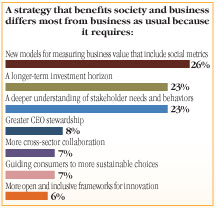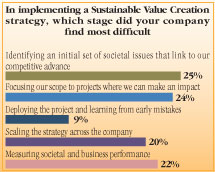- Home
- Media Kit
- Current Issue
- Past Issues
- Ad Specs-Submission
- Ad Print Settings
- Reprints (PDF)
- Photo Specifications (PDF)
- Contact Us

![]()
ONLINE
Business at Its Best: Maximizing Long-Term Profitability and Societal Impact
Editors’ Note
In this article, Charles Moore, Executive Director of the Committee Encouraging Corporate Philanthropy (CECP) and former CEO of a variety of companies, including Lapp Insulator, Allied Thermal, Clevepak Corporation, and Ransburg Corporation, provides insight into the key findings of the exclusive conversation which took place at CECP’s 6th annual Board of Boards CEO Conference in New York City on February 28, 2011.
Organizational Brief
CECP (www.corporatephilanthropy.org) is the only international forum of global CEOs and chairpersons focused on increasing the level and quality of corporate philanthropy. Membership includes over 180 leading business executives whose companies collectively account for over 40 percent of all corporate giving in the United States. Next year’s Board of Boards CEO Conference will take place in New York City on February 27, 2012.

Blending Commercial and Societal Interests
Nearly 70 global business leaders – including executive delegations from China and the Arabian Gulf – convened on International Corporate Philanthropy Day to discuss the theme “Business at its Best: Maximizing Long-Term Profitability and Societal Impact.” In this closed-door session – held annually and consistently ranked among the world’s top 10 executive events by global public relations firm Weber Shandwick – leading CEOs focused on the opportunities and implementation challenges that lay ahead when reorienting their core corporate strategies to blend commercial and societal interests.
CEOs reflected on the advances their companies have made in incorporating environmental sustainability into their operations and business practices, the development of new products or services, and even the rethinking of business models.
With those gains as a backdrop, they turned to the rising pressures they face to take action on societal issues. CEOs are motivated to do so by a range of concerns including responding to the rising needs in their communities, competing in a global marketplace, and recruiting and retaining top talent.

CEOs were challenged to think beyond philanthropy and consider weaving a process to create a positive societal impact into the fabric of the company. CECP calls this strategy Sustainable Value Creation.
Moving Beyond Business-as-Usual
In considering how Sustainable Value Creation differs from traditional strategies, CEOs shared their expectation that it requires new models for capturing societal impact, lengthier investment horizons, and a deeper understanding of stakeholder needs and behaviors.
Reflecting on these differences, 70 percent of CEOs indicated that they would not evaluate Sustainable Value Creation opportunities using the same criteria as they would for other opportunities. Yet Sustainable Value Creation opportunities must return a profit in order to justify ongoing corporate involvement despite the different approaches and timeframes required for execution.

CEO Leadership: Putting Ideas into Action
CEOs not only discussed the importance of pursuing a Sustainable Value Creation strategy, but they focused on overcoming the challenges in bringing this type of strategy to life. When asked what stage of implementation was most difficult, attendees were divided. Roughly half answered that identifying and prioritizing the best set of societal issues – ones that truly mesh business and societal interests – presented the biggest obstacle. For others, scaling the strategy across the firm and measuring results were toughest.
A Sustainable Value Creation strategy requires a company to mobilize the entire business, and to authentically and profitably commit to a chosen issue for the foreseeable future. Consequently, as with any large-scale change management effort, the CEO has a pivotal stewardship role in designing, launching, and steering the initiative.
CEOs felt confident that they could deploy initial, small-scale Sustainable Value Creation projects. However, they agreed that integrating the priorities across the entire firm would require linkages to employee incentives, new governance structures, and reinforcement by senior leadership.
Furthermore, the learning opportunities that result as a natural consequence from Sustainable Value Creation pilots were seen as a solid investment in creating enduring business value by mitigating risk and seeking new opportunities for growth now and in the years ahead.•